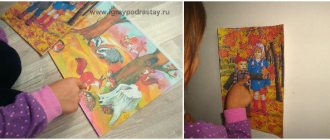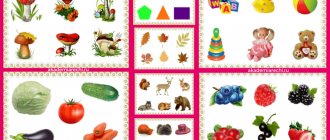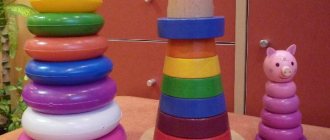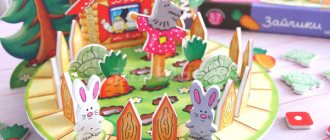It's a sad time! Ouch charm! Your farewell beauty is pleasant to me - I love the lush decay of nature, Forests dressed in crimson and gold... (And S Pushkin)
Many poets loved and sang autumn in their works. Indeed, it’s impossible not to admire autumn. It seems that nature, before falling asleep and covering the earth with a white, fluffy blanket, decided to arrange a fair of bright colors and delight us with an abundance of different shades. We adults must teach the child to see this beauty and admire it. Finger games about this wonderful time of year will help us get acquainted with changes in nature.
"Autumn".
The north wind blew: “S-s-s-s” (blowing)
I blew all the leaves off the branches... (move your fingers and blow on them)
They flew, spun and sank to the ground (wave their arms in the air)
The rain began to patter on them
Drip-drip-drip, drip-drip-drip! (tap the fingers of your right hand on the palm of your left hand)
The hail pounded on them, (with a pinch of your right hand, tap on your left palm)
It pierced all the leaves. (knock the fist of your right hand on your left palm)
The snow then powdered (smooth movements of the hands back and forth)
He covered them with a blanket. (place your right palm on your left)
Didactic game “Autumn Leaves” card index (junior group) on the topic
Didactic game for the development of sensorimotor skills in children 3-4 years old “Autumn Leaves”
Didactic tasks:
Learn to assemble a whole from parts; consolidate knowledge about color, size; develop visual perception, thinking, attention, logic; develop fine motor skills of the hands; develop speech.
Material: from colored cardboard (green, yellow, red, orange), cut out maple leaves, size (large - small), in pairs. Cut each leaf in half, leaving one pair uncut for sample.
Option 1. “Collect leaves”
Goal: to develop children's constructive skills, visual attention; develop thinking, attention, creative imagination.
Progress of the game:
The adult invites the child to assemble the leaves from the parts, noting that the leaves are of different colors and sizes.
- “A strong wind blew and the leaves scattered. Let's collect them."
Together with your child, fold the halves of the leaves to make whole ones.
Option 2. “Who has such a piece of paper?”
Purpose: to distinguish children's constructive skills, visual attention; consolidate knowledge of color (red, yellow, green, orange), size (large, small); develop speech, enrich vocabulary.
Progress of the game:
The adult gives the children one half of the cut pictures each, and keeps the remaining parts for themselves. He asks who should be given each of the halves in order to put together the whole pictures. When children choose their halves of autumn leaves, taking into account color and size, each child adds up the whole image and tells what kind of leaf he got (big red, small green, etc.)
The following options for playing with collected leaves.
Option 3. “Pick up the leaves”
Material: the same as in the previous game. Trees cut out of cardboard in yellow, red, orange, and green are added.
Goal: to teach children to distinguish colors (yellow, red, orange, green); teach to match leaves by color.
Progress of the game:
Invite the child to place the leaves on the trees of the corresponding color so that the leaves are the same color as the tree.
Option 4. “Big and small leaves”
Goal: to teach children to distinguish leaves by size, to consolidate the concepts: big - small.
Progress of the game:
The adult puts two leaves on the table and invites the child to put large leaves near the large leaf, and small ones near the small leaf.
Option 5. “Show me a piece of paper”
Goal: to teach children to show leaves according to the word denoting color. Strengthen children's ability to distinguish and name colors (green, yellow, red, orange).
Progress of the game:
The adult invites the child to show yellow leaves, red, green, orange.
Option 6. “Show me a piece of paper”
Goal: to teach children to show leaves by word indicating color and size. Strengthen children's ability to distinguish and name colors; consolidate the concepts of “big” and “small”.
Progress of the game:
The adult asks the child to find a piece of paper with a certain color and size.
- “Show me the big red leaf.”
- “Show me the little green leaf,” etc.
Option 7. “Name the leaf”
Goal: to teach children to name the color and size of a leaf. Strengthen children's ability to distinguish and name colors (green, yellow, red, orange) and sizes (big and small), develop speech.
Progress of the game:
The adult points to the piece of paper, and the child names what color and size.
Option 8. “Find a pair.” Goal: the ability to select pairs based on similar sensory attributes of color or size; develop visual perception. Progress of the game:
An adult invites the children to look at the leaves and asks them to name the color. Then he invites the children to pick up pairs of colored leaves.
Complication: take from 4 to 8 leaves.
Option 9. “Find the extra leaf”
Goal: to develop children's visual attention and thinking, logic.
Progress of the game:
The adult invites the child to choose an extra leaf. In front of the child, leaves are laid out, united by some characteristic, for example, by size or color; one of them does not have such a characteristic and is superfluous.
Option 10. “What has changed?” Goal: development of visual perception, memory, speech, enrichment of vocabulary. Progress of the game:
An adult lays out several pieces of paper on the table. The child is asked to close his eyes. An adult removes or swaps the leaves.
- "What changed?".
Invite your child to talk about the changes. Option 11. Outdoor game “1, 2, 3, collect a piece of paper!”
Objectives: to develop children's constructive skills, visual attention; develop thinking, consolidate knowledge about color and size, develop auditory and visual perception.
Progress of the game:
An adult gives children one half of the cut pictures. Children walk around the playground. At a signal, they scatter and run in any direction. At the signal “collect 1, 2, 3 leaves” they stand in pairs. (Music accompaniment is used).
Complication: change the pair each time.
"Autumn"
The sun is already barely warm; (we spread our fingers on both hands and connect
palms together, then join fingers)
Migratory birds have flown south; (we wave our arms like wings)
The trees are bare, the fields are deserted, (we raise our hands)
The first snow covered the ground. (smoothly lower the handles down)
The river is covered with ice in November - (we squeeze our hands into a lock)
It's late autumn in the yard. (we spread our hands in front of us)
"Mistress"
The hostess came from the market one day, (we walk our fingers on the table)
The hostess brought it home from the market: (clap our hands)
Potatoes, cabbage, carrots, peas (we fold them one by one)
fingers on the left hand)
Parsley and beets, oh! (clap our hands)
Covered with a lid, in a stuffy pot (we collect the right palm with a “bucket”, cover the left one on top like a lid)
They were boiling, boiling in boiling water: (we twist our hands in front of us)
Potatoes, cabbage, carrots, peas (we bend our fingers one by one)
Parsley and beets, oh! (clap our hands)
And the vegetable soup turned out to be quite good! (show thumb)
"Hedgehog"
One hand (palm open, fingers spread) is a hedgehog, the fingers of the other hand are forest animals.
We squeeze each finger of the other hand with one hand.
“A hedgehog walks through the forest, handing out nuts to everyone. (spread the fingers of the right hand - this is a hedgehog, the left hand is clenched into a fist)
Little white bunny (bend the little finger),
Gray top (bend the ring finger)
Red fox (bend the middle finger),
To the sister squirrel (bend the index finger),
And the hedgehog gives pine cones to the teddy bear (bend the thumb).
A set of didactic games for the RPPS “Purple Forest”
SET
Didactic games for RPPS “Purple Forest”
Developer: Lyapustina O.A.
A set of didactic games for the subject environment “Purple Forest” aimed at the cognitive development of young children / comp. O.A. Lyapustina. – Kamyshlov: GAPOU SO “Kamyshlov Pedagogical College”, 2020
Head: Shtyrkina A.I. teacher of pedagogical disciplines
The set contains didactic games for the subject environment “Purple Forest” aimed at the cognitive development of young children. This set has great pedagogical significance in the cognitive development of young children. It can be used by teachers of preschool educational organizations, students of pedagogical colleges in their professional practice and parents. The set includes the following sections: Spring, Dear Mommy, My Mom, I'm growing: healthy nutrition, Me and my friends, Me and the world around, Favorite fairy tales.
© GBPOU SO "Kamyshlovsky Pedagogical College", 2020
| Content | |
| Explanatory note…………………………………… Calendar and thematic planning……………. | 6 |
| — “Spring in a magical forest”………………………… | |
| - “Which stream is longer?”………………………….. | |
| - "Who is faster?"……………………………………… | |
| — “Multi-colored beads”………………………………. | |
| — “Fruits and vegetables for the bunny”……………………… | |
| — “Apples and pears”……………………………………. | |
| Section 4: Me and my friends…………………………………… | |
| - "Bear"……………………………………………… | |
| — “Bouquet for Fifa the Caterpillar”……………………… | |
| Section 5: Me and the world around…………………………………….. | |
| — “Rain in a fairytale forest”………………………. | |
| - “Help the hedgehogs collect leaves”…………….. | |
| Section 6: Favorite fairy tales…………………………….. | |
| - “Let’s help the bun”……………………………….. | |
| — “House for a Hedgehog”…………………………………… | |
| Conclusion…………………………………………………. | |
| Bibliography………………………………………… |
Explanatory note
“Without play there is not and cannot be full-fledged mental development. A game is a huge bright window through which a life-giving stream of ideas and concepts flows into the child’s spiritual world. A game is a spark that ignites the flame of inquisitiveness and curiosity.”
V.A. Sukhomlinsky.
Early childhood is the most amenable period to pedagogical influence. Everything is mastered and learned for the first time. There are no skills yet, no ideas, no knowledge. But the predisposition to assimilation is great, the ability to learn is high, since there are innate mechanisms that serve as the basis for the formation of mental qualities characteristic only of humans. If you do not pay attention to certain areas that can be most successfully implemented precisely at a specific age stage, then in the near future a delay in significant skills is almost inevitable.
It is at an early age that intensive brain development and the formation of mental abilities occur. This happens most effectively in the leading activity - the game.
A didactic game is a unique form of learning that meets the child’s characteristics
Cognitive development in the federal state educational standard for preschool education presupposes the involvement of the child in independent activities, the development of his imagination and curiosity. In order to effectively develop the child’s cognitive sphere, the best option is to organize and conduct didactic games aimed at the cognitive development of children.
The subject-developmental environment “Purple Forest” promotes the cognitive development of children. With the help of a fairy-tale space, unusual characters and methodological fairy tales, the child becomes the protagonist of events and fairy-tale adventures.
"Purple Forest" includes many different elements, colorful and varied. Amazing fairy-tale characters are accompanied by interesting and instructive tales. While playing with the purple forest, children develop fine motor skills, because... The manual contains a lot of small parts with Velcro, inserts and cords - fun things that are fixed, inserted, and applied to the carpet.
The cognitive activity of children is formed: you can decorate the forest according to the seasons, house animals and birds, get acquainted with natural phenomena, plant flowers in a clearing, there are many options, it all depends on the imagination of the teacher and the children.
The didactic games offered in the set are aimed at ensuring the accumulation of ideas about the shape, color and size of objects, as well as the development of sensory perception.
Tales of the Violet Forest contain stories with wonderful transformations, adventures of funny characters and at the same time entertaining questions, problematic tasks, exercises in modeling and transforming objects. With their use, it provided conditions for the development of the child’s cognitive activity, curiosity, and observation; situations are created for the manifestation of independence and initiative, self-expression and, in general, personal development.
The use of the presented games helps to develop children's interest, curiosity and cognitive motivation; to form cognitive actions, the formation of consciousness; development of imagination and creative activity; the formation of primary ideas about oneself, other people, objects of the surrounding world.
The set includes original games and games proposed by V.V. Voskobovich. Didactic games were selected in accordance with the theme of the week, the age characteristics of the children, the level of cognitive development and in accordance with the work program of the early age group. There are two games for each topic, each game has a complication, which makes it possible to vary the game taking into account the characteristics of age.
The kit has great pedagogical significance in the cognitive development of young children. It can be used by teachers of preschool educational organizations, students of pedagogical colleges in their professional practice and parents.
Calendar and thematic planning
| Month | A week | Topic of the week | Didactic game | Target |
| 1 | 2 | 3 | 4 | 5 |
| March | 1 Week | Spring | "Spring in the Magic Forest" | Expand children’s knowledge and ideas about the signs of spring; formation of ideas about primary colors. |
| 2 week | “Which stream is longer?” | Develop an eye; improve the ability to compare lengths through application. | ||
| 3 week | Dear mommy, my mom. | "Who is faster?" | Develop an eye; improve the ability to compare lengths through application, development of coherent speech. | |
| 4 week | "Multi-colored beads" | Develop knowledge about size (large, small); learn to alternate elements by size. | ||
| April | 1 Week | I'm growing: healthy eating | "Fruits and vegetables for the bunny" | To develop the ability to classify objects into groups “vegetables and fruits”; formation of ideas about primary colors. |
| 2 week | "Purple Forest" "Apples and Pears" | Develop attention, thinking, learn to classify objects by type. | ||
| 1 | 2 | 3 | 4 | 5 |
| 3 week | Me and my friends | "Bear" | Form ideas about primary colors; develop coordination of movement, general and fine motor skills. | |
| 4 week | "Bouquet for Fifa the Caterpillar" | Form ideas about primary colors. | ||
| May | 1 Week | Me and the world around | "Rain in a fairy forest" | Expand ideas about the characteristics of objects (large - small), consolidate these concepts in speech; develop visual perception of size. |
| 2 week | “Help the hedgehogs collect leaves” | To develop the ability to identify a large and a small sign; development of the ability to group by size. | ||
| 3 week | Favorite fairy tales | "Let's help Kolobok" | Form ideas about primary colors, cultivate a sense of mutual assistance. | |
| 4 week | "House for a Hedgehog" | Learn to visually correlate the size and color of objects. |
Topic: “Spring in a magical forest”
Pedagogical goal: To expand children’s knowledge and ideas about the signs of spring; form ideas about primary colors.
Game goal: Assemble the sun from individual parts, selecting them by color (yellow)
Complication: Assemble the sun from individual parts, alternating in color (red, yellow)
Play equipment: “Purple Forest”, Kohle the gnome, the sun, yellow and red rays.
Progress of the game: The teacher tells the children that spring has come to the purple forest. Draws attention to the sad gnome Kokhle. Let's ask why he is sad. He is sad because there is a lot of snow and it is not melting. Guys, do you know how to help him? That's right, for the snow to start melting, it needs to be warmed by the sun.
Children come up to the rug and make a sun. Kohle thanks the children.
Topic: “Which stream is longer?”
Pedagogical goal: To expand children’s knowledge and ideas about the signs of spring; develop an eye; improve the ability to compare lengths by applying
Game goal: Determine the longest and shortest stream by eye.
Complication: Launch blue boats into a long stream, and green ones into a short stream.
Play equipment: “Purple Forest”, gnomes Kohle and Zele, blue ropes of two colors, blue and green boats.
Progress of the game: With the onset of spring, the Violet Forest becomes warmer every day. The sun is getting hotter. The snow began to melt and streams began to run. Kohle and Zele made paper boats and ran to the streams. Kohle wants to launch the boat into the longest stream, and Zele into the shortest stream. Guys, how can I help them? Which stream is the longest? Which is the shortest?
Topic: "Who is faster?"
Pedagogical goal: To expand children’s knowledge and ideas about spring holidays; develop an eye; improve the ability to compare lengths through application, development of coherent speech.
Game goal: Determine who will run to the flower faster (determine “by eye”)
Complication: Determine who will run to the flower faster (add another hedgehog and a middle path).
Play equipment: “Purple Forest”, hedgehogs of two sizes, a flower, multi-colored ropes of two colors and two sizes.
Progress of the game: On March 8, the hedgehogs decided to give their mother a flower. They followed him into the forest. For a long time the hedgehogs searched for the largest and most beautiful flower. In a large clearing they saw a beautiful, large flower, and everyone wanted to give it as a gift. The hedgehogs each ran along their own path. Who will run to the flower faster? Who has the longest track? Who has it shorter?
Topic: “Colorful beads”
Pedagogical goal: To develop knowledge about size (large, small); learn to alternate elements by size.
Game goal: Collect beads from berries, alternating them by size (large, small).
Complication: Collect beads from berries alternating them by size (2 large, 1 small).
Play equipment: “Purple Forest”, large and small red mugs (“Multi-colored mugs 1”), white strings (“Multi-colored ropes mugs 1”), the fairy-tale image of Mishik the Bear.
Progress of the game: The teacher tells the children that in the Violet Forest, Mishik the Bear found large and small berries in a clearing. He wants to make beads for his mother so that the berries alternate: big, small, big, etc. Then the children select and “string” the berries on strings (attach circles located on the carpet to the strings). The teacher emphasizes with his voice and accompanies by showing what size beads are taken. Children select beads first with the teacher, then on their own.
Topic: “Fruits and vegetables for the bunny”
Pedagogical goal: To expand children's knowledge and ideas about fruits and vegetables; develop the ability to classify objects into groups “vegetables and fruits”; form ideas about primary colors.
Game goal: Collect fruits and vegetables in a basket of a certain color.
Complication: Collect fruits and vegetables in a basket of a certain color and size.
Play equipment: “Purple Forest”, hedgehog, bunny, basket strings (yellow and red), fruits and vegetables.
Progress of the game: The hedgehog and the bunny are great friends. One day the bunny got sick. The hedgehog took a basket of fruits and a basket of vegetables and went to visit the bunny. The hedgehog was in such a hurry to get to his friend that he stumbled and dropped the baskets. Fruits and vegetables are mixed up. The hedgehog is sitting crying. Guys, let's help the hedgehog collect fruits in a yellow basket and vegetables in a red basket. The hedgehog thanks the children.
Topic: “Apples and pears”
Pedagogical goal: To expand children's knowledge and ideas about fruits and vegetables; develop attention, thinking, learn to classify objects by type.
Game goal: Attach apples to a tall tree and pears to a low one.
Complication: Attach red apples to a tall tree, yellow apples to a low tree, green pears to a medium tree.
Play equipment: "Purple Forest", tree high and low, Gnome Jelly, apples and pears.
Progress of the game: Dwarf Jelly was walking through the Purple Forest and saw that fruits were falling from the trees: apples and pears. He began to think about how to get the fruit back. Let's try to attach apples to a tall tree and pears to a low one. Gnome Jelly thanks the children.
Section 4. “Me and my friends”
Theme: "Teddy Bear"
Pedagogical goal: To form ideas about primary colors; develop coordination of movement, general and fine motor skills.
Game goal: Fill the jar with honey (yellow circles).
Complication: Fill the jar with honey (yellow, large circles).
Play equipment: “Purple Forest”, “Multi-colored ropes 1”, fairy-tale image of Teddy Bear Mishik, yellow mugs.
Progress of the game: The teacher invites the children to get acquainted with Mishik, fixed on the carpet. Children introduce themselves by saying their name. The teacher offers to treat him with honey. Draws children's attention to a jar modeled from a string on a fragment of the “Purple Forest”. He asks what it is for. Listens to the children's suggestions and offers to fill the jar with honey (yellow circles). Children do the work all together, taking turns attaching circles. When the jar is full, the teacher offers to give it to Mishik. Mishik thanks the children.
Topic: “Bouquet for Fifa the Caterpillar”
Pedagogical goal: To form ideas about primary colors.
Game goal: Help the bunny and the squirrel collect flowers of a certain color.
Complication: Help the bunny and the squirrel collect flowers of a certain color and size.
Play equipment: “Purple Forest”, “Fifa” caterpillar, flowers of primary colors, bunny, squirrel.
Progress of the game: Fifa the Caterpillar invited her friends Bunny and Squirrel to her birthday party. Friends decided to give her flowers. The bunny began to collect red flowers, and the squirrel began to collect yellow ones. Let's help them. What color does a bunny pick flowers, and what color does a squirrel pick? The squirrel and the bunny thank the children.
Section 5. “Me and the world around”
Topic: “Rain in a fairy forest”
Pedagogical goal: To expand children’s knowledge and understanding of the inhabitants of the forest; expand ideas about the characteristics of objects (large - small), consolidate these concepts in speech; develop visual perception of size.
Game goal: Place large droplets on the big cloud, and small droplets on the small one; hide large animals under large Christmas trees, and small ones under small ones.
Complication:
Play equipment: “Purple Forest”, hedgehogs, mice, large and small clouds, large and small droplets, large and small Christmas trees, the sun.
Progress of the game: The teacher invites the children to go to the fairy forest. He tells the children: “In a fairytale forest, everything is magical and unusual, even animals.” The teacher suggests finding and examining the inhabitants of the forest (mice, hedgehogs), and comparing them by size. But at this time clouds appeared in the sky (the teacher attaches a large and a small cloud). And the rain started dripping, from the big one - large drops, from the small one - small ones (the teacher suggests placing the droplets on his cloud). The animals were afraid of the rain and hid under the Christmas trees: the big ones under the big one, the small ones under the small ones (the teacher suggests that the children hide the animals from the rain). The rain stopped, the sun came out, the animals came out into the clearing. The animals thank the children and say goodbye.
Topic: “Help the hedgehogs collect leaves”
Pedagogical goal: To expand children’s knowledge and understanding of the inhabitants of the forest; to develop the ability to identify a large and a small sign; develop the ability to group by size.
Game goal: Collect leaves of a certain size.
Complication: Collect leaves of a certain size and color.
Play equipment: “Purple Forest”, leaves of two sizes, hedgehogs of two sizes.
Progress of the game: The hedgehogs walked through the Purple Forest and saw a lot of beautiful leaves. They liked them so much that they decided to decorate their homes with them. The big hedgehog decided to collect large leaves, and the little hedgehog decided to collect small ones. But they just can’t cope on their own. Let's help the hedgehogs.
Section 6: “Favorite Tales”
Topic: “Let’s help Kolobok”
Pedagogical goal: To expand children's knowledge and ideas about fairy-tale characters; form ideas about primary colors, cultivate a sense of mutual assistance.
Game goal: Build a path of yellow leaves for Kolobok.
Complication: Build a path for Kolobok alternating yellow and red leaves.
Play equipment: “Purple Forest”, yellow leaves, square, triangle, image of Kolobok.
Progress of the game: A house of geometric shapes is built on the carpet, the Kolobok is fixed among the trees. The teacher explains to the children that the bun is lost. He needs to get out of the forest to the house. Invites children to build paths for Kolobok from the forest to the house from yellow leaves. The children complete the task, then invite Kolobok to run along the path to the house. Kolobok thanks each child.
Topic: “House for a hedgehog”
Pedagogical goal: To teach to visually correlate the size and color of objects.
Game goal: Build houses for hedgehogs from two figures of the same size.
Complication: Build houses for hedgehogs from two figures of the same size and the same color
Play equipment: Large and small hedgehog, squares and triangles of different sizes and different colors.
Progress of the game: Funny Hedgehogs lived in the forest,
The Hedgehogs had old houses.
Suddenly thunder rolled across the sky
And the Hedgehogs’ house fell apart.
So the hedgehogs remained on the street,
They felt damp and cold without houses.
Guys, look, all the details from the houses are mixed up. The teacher offers to help the hedgehogs build new houses, from two parts of two sizes, pronouncing “big - small” in speech. Look at the size of Hedgehogs? Let's build a big house for the big hedgehog, and a small one for the little hedgehog. The hedgehogs thank the children for their new houses.
Conclusion
The principles underlying these games - interest - cognition - creativity - become as effective as possible, since the game speaks directly to the child in the kind, original, funny and sad language of a fairy tale, intrigue, funny character or invitation to adventure. In every game, the child always achieves some kind of “objective” result. Constant and gradual complication of games (“in a spiral”) makes it possible to maintain children’s activity in the zone of optimal difficulty.
Educational games for the “Purple Forest” educational program create conditions for creativity and stimulate the development of the child’s mental abilities. The adult can only use this natural need to gradually involve the children in more complex forms of play activity.
Bibliography
1. V.V. Voskobovich, L.S. Vakulenko. Educational games by V.V. Voskobovich with preschool children. - St. Petersburg: LLC "Politon-SPb", 2013. - 148 p.
2. V.V. Voskobovich, L.S. Vakulenko. Educational games of V.V. Voskobovich in working with children of preschool and primary school age. - St. Petersburg: “Own Publishing House”, 2014.-172 p.
3. V.V. Voskobovich Developing subject-spatial environment “Purple Forest”. - St. Petersburg: “Own Publishing House”, 2014
4. Voskobovich V.V. Technology of intensive intellectual development of preschool children “Fairytale labyrinths games”. St. Petersburg: Scientific Research Institute “Girikond”, 2000.





